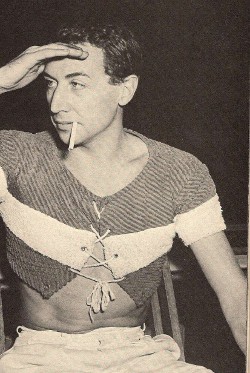 Jack Cole and Betty Grable were both friends and colleagues. He called her “Thumper” and she matched his penchant for salty language. He kicked her sagging career into high gear and she relied on him. I love how she shakes it in this number, video below.
Jack Cole and Betty Grable were both friends and colleagues. He called her “Thumper” and she matched his penchant for salty language. He kicked her sagging career into high gear and she relied on him. I love how she shakes it in this number, video below.
It’s “How Come You Do Me Like you Do?” from THREE FOR THE SHOW (Columbia, 1955).
In the heyday of the Hollywood studio system, the 1930s thru the ’50s, film stars (not all, not Garbo) had to act, sing, and dance. These versatile, talented people applied themselves, and they had to deliver. I write this consideration of the kudos Natalie Portman is getting for her faux ballerina work in BLACK SWAN. But we’re in a different era.
Dance like this — blazing, butt-kicking, stylish and smart — didn’t exist on film before Jack Cole, nor since. Yes, Cole’s choreography is smart. His dances have high I.Q., with phrases that make sense physically, musically, visually, and they sizzle on the screen. So take it away, Betty and Jack:
[apologies: it seems that this video has been removed from YOUTUBE.]
There are many Jack Cole signature touches in this number. To highlight a few:
- Primary colors. Cole was involved in the art design of his sequences and he had a great eye. He loved clashing loud primary colors, e.g., that blood-red backdrop. What about that crazy zebra-striped floor?
- Caribbean theme. Cole brought Afro-Caribbean as well as Indian influences into American jazz dance, which, by the way, he invented.
- Hats! Cole loved ’em. There’s like four kinds of hats in this number. I love the tall turbans.
- Low-camera-angle shots of dancers and a busy, richly filled frame. Watch how he loads dancers into the frame while the camera pans — from 0:21 to 0:31.
- Overhead close-up shot of Grable. He made sure his leading ladies looked fantastic and that the camera slathered over them. He did this for Rita Hayworth and Monroe as well.
- Stratified frame. Dancers bodies dissect the frame horizontally, with a base line of the men low down in the frame and an overlay of chorines moving through. He clusters dancers into the frame corners.
- Costumes dance too. Note how the girls play with those open-fronted skirts. That dates from Denishawn. Cole’s nightclub work ramped it up.
- Integration of dancers with music, costume and set. The slats on the door and in silhouetted backdrops get replicated in the stripes of the mens’ tee shirts. This level of integration is all Jack Cole.
- Gorgeous, athletic men in motion; men hunching low to the ground, pulsing, like cats.
- Exposed midriffs, if he didn’t start this fashion trend, he perpetuated it.
- Stripper bump and grind. Cole was a nightclub guy. He watched, loved and respected strippers.
- Sex! The whole thing is oozing with it. See: 2:50.
Like this? Read more
- Let’s see what Cole did for Marilyn. And read about it here.
- Let’s see what Cole did for Mitzi Gaynor

I hear you loud and clear and you are correct Karenatasha. Jack Cole channeled African American dance into the mainstream. Of all the movement streams he blended together, I believe black dance is the strongest component. In this clip we see Caribbean. What’s so astonishing is how he took all these influences, mashed them up and came out with his inimitable style that no one else was doing. p.s. You know that he had Marie Bryant, a great A-A dancer, the best, coaching Betty Grable, correct?
“Cole brought Afro-Carribean as well as Indian influences into American jazz dance, which, by the way, he invented.”
Oh, really? He invented American jazz dance? Nice way to take all credit away from the African-American dancers who actually invented it and which he built on. Now I’m not taking anything away from Cole, who is absolutely brilliant and groundbreaking. But I object to giving him credit that he doesn’t deserve and obliterating the creation of an entire people. Cole did enough, and his accomplishments are so profound, that no exaggeration is required.